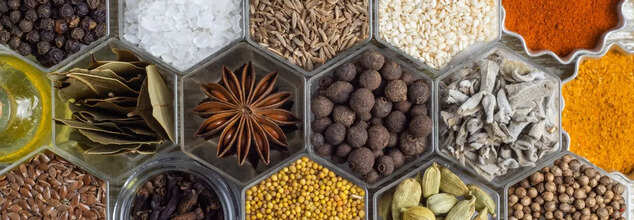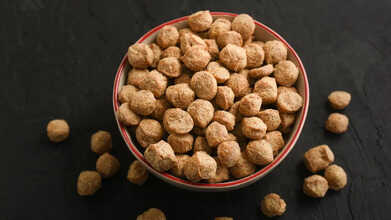- Health Conditions A-Z
- Health & Wellness
- Nutrition
- Fitness
- Health News
- Ayurveda
- Videos
- Medicine A-Z
- Parenting
- Web Stories
Low On Energy? 10 Herbs That You Must Include In Your Diet

Herbs And Spices (Credit: Canva)
Herbs have long been used for their potential health benefits, and some may help boost your energy and sharpen your focus. While no supplement can replace a balanced diet, regular exercise, and quality sleep, certain herbs may offer a natural energy lift. However, before incorporating them into your routine, it’s essential to consult with a healthcare provider to ensure their safety, especially if you’re on medication.
Research has shown that herbs (like rosemary sage and oregano) and culinary spices (like turmeric and black pepper) have numerous health benefits. They are also effective in preventing diseases like cancer, diabetes and several neurodegenerative diseases.
10 Herbs That Can Bolster Your Physical And Mental Health
Ginseng is widely known for its energy-boosting properties. Studies suggest it may enhance brain function and physical performance. It contains compounds like ginsenosides, which are believed to improve mental alertness and reduce fatigue. However, it can cause side effects like insomnia and may interact with certain medications.
Sage has been linked to improved memory, focus, and reaction times. Some research indicates that sage supplements could enhance cognitive function by increasing the availability of acetylcholine, a neurotransmitter critical for brain health. However, its effects are more noticeable in supplement form than in culinary use.
Commonly found in energy drinks, Guarana contains caffeine levels higher than coffee. While it may help increase short-term alertness and memory, it can also lead to side effects such as increased heart rate, anxiety, and dehydration if consumed excessively.
Bacopa Monnieri has long been used in Ayurvedic medicine to support memory and cognitive function. Studies suggest Bacopa Monnieri can improve word recall and verbal learning, thanks to its neuroprotective compounds called bacosides. Side effects are generally mild, including gastrointestinal discomfort.
Inhalation of Peppermint oil is believed to boost energy and mental clarity. Some studies have shown that the scent of peppermint may improve alertness and cognitive performance. However, more research is needed, and taking peppermint oil orally may cause stomach issues in some individuals.
Rosemary oil has shown potential in improving memory, learning, and cognitive tasks. Research suggests that the scent of rosemary may aid in mental performance and could protect against neurodegenerative diseases like Alzheimer's. More research is needed to confirm these findings in larger studies.
Known for its stress-reducing qualities, Rhodiola Rosea is also used to boost mental clarity and endurance. Some studies suggest it may alleviate fatigue, improve mood, and enhance cognitive function, especially under stress. Side effects may include dizziness or dry mouth.
Since ancient times, Ashwagandha has been used in traditional medicine to improve focus and mental alertness. Research suggests that it can enhance cognitive performance, particularly in older adults, and improve sleep quality. It is generally well tolerated, but it may cause gastrointestinal upset in some individuals.
There is empirical evidence that Gotu Kola improves cognitive function and mood. While some studies show it may help with memory and mental clarity, other research has not found significant benefits. Its use in enhancing energy levels requires further exploration.
Maca root, a plant native to Peru, is celebrated for its ability to increase energy and stamina. It has been found to enhance athletic performance and reduce anxiety. However, it’s important to note that Maca may be contaminated with banned substances in certain supplements, so caution is advised.
Chicken Breast Vs Chicken Liver: Which Is More Nutritious?

Credits: Canva
Dr. Dominik Nischwitz, a dentist based in Germany, highlights on his Instagram that organ meats like liver are a nutrient-dense food, calling them "nature's multivitamin via real food," and suggests that eating organs was historically "prized & classed as a real luxury". His perspective aligns with how predators in the wild often prioritize organs like the brain, heart, and bone marrow over muscle meat.
A key reason for this prioritization is the immense concentration of nutrients in organs, which are essential for running "EVERY biochemical process in the human body especially your metabolism".
He has also posted on his Instagram @drdome1, comparing chicken liver with chicken breast. The post noted that chicken breast has 165cals per 100grams, while liver has 167cals per 100grams. However, the chicken breast has 0% vitamin A, 0% vitamin C, 1% folate, and 6% vitamin B12. Whereas, he noted that chicken liver has 267% vitamin A, 47% vitamin C, 144% folate, and 281% vitamin B12.
Chicken Liver's Vitamin Powerhouse
Chicken liver is significantly richer in numerous vitamins compared to chicken breast, offering a high percentage of the daily value (DV) for several B vitamins and Vitamin A.
Vitamin B12: Chicken liver has a massive amount of Vitamin B12, providing 675% more of the daily needs compared to chicken breast. Per 100 grams, chicken liver contains 16.58 μg of Vitamin B12, while chicken breast only has 0.37 μg.
Vitamin A: Chicken liver is an exceptional source of Vitamin A, containing 482 times more than chicken breast. Per 100 grams, chicken liver has 11,078 IU of Vitamin A, compared to 23 IU in chicken breast. This high content is necessary for various processes in the body, including those that regulate metabolism.
Other B Vitamins and Folate: The liver is loaded with all B vitamins. Specifically, per 100 grams, chicken liver has more Vitamin B2 (1.778 mg vs. 0.125 mg), Vitamin B5 (6.233 mg vs. 1.04 mg), and Folate (588 μg vs. 4 μg). These are crucial, for example, with B2 helping make FAD for fatty acid utilization, and B3 needed to make NAD+.
While chicken liver excels in these vitamins, the one exception is Vitamin B3, which chicken breast is richer in.
Essential Mineral Content
In addition to vitamins, chicken liver is a standout source of key minerals.
Iron: Chicken liver contains 8.99 mg of Iron per 100 grams, which is significantly more than chicken breast's 1.14 mg. This represents a 688.6% increase in Iron content for the liver.
Copper and Selenium: The liver is an excellent source of Copper. Chicken liver has 0.492 mg of Copper, substantially more than the 0.054 mg in chicken breast. It also contains more Selenium (54.6 μg vs. 26.2 μg). The presence of copper is important for how the body handles oxygen.
Zinc and Manganese: Compared to chicken breast, chicken liver is richer in Zinc and Manganese, showing a 147.2% and 1114.3% increase, respectively, in these minerals.
Fats and Cholesterol: Although chicken liver has more beneficial nutrients, it also contains more Cholesterol (345 mg per 100g) than chicken breast (91 mg per 100g).
Protein, Calorie, and Misconception Facts
While chicken breast is generally a better source of protein (33.44 g vs. 16.92 g per 100g), chicken liver is still considered a "VERY good source of protein" and is "VERY cost effective". Calorie content is very similar, with raw chicken liver at 119 kcal per 100g and cooked chicken breast at 187 kcal per 100g.
The notion that liver stores toxins is a "bogus claim." In a healthy animal, the liver's function is to transport and remove toxins from circulation, moving them to "less important and energetic tissue such as adipocytes (fat cells)". Historically, humans consumed the whole bird or animal, including the carcass for bone broth, indicating a shift in modern eating habits toward only muscle meat like chicken breast.
Think Soya Chunks Are Healthy? Gut Specialist Warns They May Harm Your Gut

Credits: Canva
In recent years, vegetarian diets have grown in popularity as more people turn to plant-based options to replace animal protein. Since meat is a key source of protein, vegetarians often look to alternatives such as soya chunks, which are widely marketed as high-protein, low-fat substitutes.
Soy has always been a controversial topic in nutrition. Research suggests it may offer benefits like better heart health, improved blood sugar control, reduced menopause symptoms, and possibly lower cancer risk. At the same time, many experts have raised concerns about its safety and long-term impact.
What Are Soya Chunks?Soya chunks, also known as textured vegetable protein, are made from defatted soy flour. Their meaty texture and protein content make them a popular choice in curries, stir-fries, soups, and even as a filling in tacos and burgers. For many vegetarians and vegans, they have become a convenient source of protein.
Are Soya Chunks Good for Gut Health?
According to gut and hormone health expert Tanisha Bawa, the ‘high-protein’ tag attached to soy products such as soya nuggets, soya chaap, and even soy milk is misleading. In a recent video, she warned that these products may actually be worse than junk food.“These soy nuggets are industrially processed and often contain 80 to 90 percent refined flour,” Tanisha explained. “Instead of getting quality protein, you’re consuming empty calories that spike blood sugar, disrupt hormonal balance, and fuel inflammation.”
ALSO READ: Fact Check: Does the Paleo Diet Really Improve Your Health? Experts Explain
She further highlighted that such ultra-processed soy products damage gut health rather than support it. In her words, “I do not recommend soy in any way or form because they contain anti-nutrients that block the absorption of essential vitamins and minerals.”
Healthier Alternatives to Soya Chunks
Instead of relying on soya chunks for protein, Tanisha recommends nutrient-dense and gut-friendly alternatives, such as:- Peas
- Mushrooms
- Spirulina
- Organic tempeh
- Vegan pea protein
- Quality vegan protein shakes
- Whole grains like quinoa and amaranth (with peas for added protein)
- Chia puddings fortified with vegan protein
- Nuts, seeds, and almond butter
Do Soy Chunks Also Offer Health Benefits?Soy-rich diets have been studied for several possible health benefits. Research shows that soy protein may modestly reduce LDL or “bad” cholesterol while raising HDL or “good” cholesterol. For instance, reviews suggest that consuming around 25 grams of soy protein daily could lower cholesterol by about 2–3 percent, with greater impact when soy replaces animal protein. Minimally processed options such as tofu, tempeh, soybeans, and edamame appear to be more effective than highly processed products or supplements.
ALSO READ: Can Overconsumption of Matcha Impact Your Heart and Overall Health?
Soy foods may also support heart health. Isoflavones found in soy are believed to reduce inflammation in blood vessels and improve their flexibility, lowering the risk of heart disease and stroke. Some studies even link soy consumption to a 15 percent lower risk of death from heart disease.
In terms of blood pressure, soy is rich in arginine and isoflavones, compounds that may help reduce levels slightly, particularly in people with hypertension. Similarly, soy isoflavones have been tied to modest improvements in blood sugar control and insulin sensitivity, especially among menopausal women and those with type 2 diabetes.
Finally, soy may influence fertility. Some research suggests improved outcomes in women undergoing fertility treatments, though other studies note potential hormonal effects at higher isoflavone intakes.
Fact Check: Does the Paleo Diet Really Improve Your Health? Experts Explain

Credits: Canva
Adopting a healthier diet is something everyone should aim for, but figuring out the best approach can be confusing. Should you eat more grains? Cut out dairy? Limit sugar and fats? Diets such as the Paleo diet, inspired by the eating habits of our hunter-gatherer ancestors, have grown in popularity because they offer guidance on what to eat to support overall health.
But what exactly is the Paleo diet, and is it right for you? To clarify, we spoke with Lena Bakovic, a Registered Dietitian Nutritionist with over eight years of experience at Top Nutrition Coaching.
What Is the Paleo Diet?
According to Lena, the Paleo diet seeks to emulate the eating patterns of hunter-gatherers from thousands of years ago. Advocates of this approach believe it can help prevent chronic illnesses and reduce inflammation. It is also thought to support weight management, stabilize blood sugar, boost energy, and enhance athletic performance.ALSO READ: Mediterranean Diet Could Lower Alzheimer’s Risk by 35%, Study Finds: How It Supports Brain Health
How Does the Paleo Diet Work?The focus of the Paleo diet is on whole, unprocessed foods. This means plenty of fruits and vegetables, lean proteins, and avoidance of highly processed items and foods high in sugar and unhealthy fats. Lena explains, “The diet is appealing because of its potential health benefits. However, like many ‘fad’ diets, it excludes certain food groups, including grains such as bread, cereals, and pasta, as well as legumes like beans and lentils. Dairy is also left out because hunter-gatherers primarily relied on animals for meat, not milk.”
Foods Included in the Paleo Diet
The diet emphasises whole fruits and vegetables, nuts and seeds (except peanuts, which are legumes), wild-caught seafood, eggs, and grass-fed meats. Plant-based oils, such as olive and avocado oil, are also included. Potatoes are generally avoided due to their high starch content and impact on blood sugar. Grass-fed poultry and red meats, including chicken, turkey, beef, and pork, are preferred, and bacon is allowed if it comes from grass-fed sources.Benefits of the Paleo Diet
One key advantage, Lena notes, is the diet’s high protein content. Protein promotes satiety, helping prevent overeating, and supports the maintenance and growth of muscle mass. Wild-caught seafood adds omega-3 fatty acids, which are known to benefit heart health and reduce inflammation. The emphasis on natural, minimally processed foods ensures a variety of nutrients. The diet is rich in fiber, which supports digestive and cardiovascular health, and offers vitamins, minerals, and antioxidants from fruits and vegetables, helping protect against deficiencies and combat harmful free radicals.ALSO READ: Never Eat Chia Seeds THIS Way: Doctor Warns Of Hidden Dangers
Can the Paleo Diet Improve Health?Scientific studies have explored the potential benefits of the Paleo diet to determine whether it should be recommended by healthcare professionals. A 2015 review of four randomized controlled trials involving 159 participants with components of metabolic syndrome found that following a Paleolithic diet led to greater short-term improvements in waist circumference, triglyceride levels, blood pressure, HDL (good) cholesterol, and fasting blood sugar compared with control diets.
Another study published in the Nutrition Journal examined multiple trials and found that participants on a Paleo diet lost an average of 3.5 kilograms and saw reductions in waist circumference and BMI compared with those following other recommended diets. The researchers suggest that the Paleo diet may help reduce the risk of chronic diseases, particularly since excess body weight is a major risk factor for their development.
Research suggests that the diet can support weight management, improve metabolic health, and reduce the risk of chronic diseases. While it may not be suitable for everyone, understanding its principles and benefits can help individuals make informed choices about whether this ancestral-inspired diet fits into their lifestyle.
© 2024 Bennett, Coleman & Company Limited

